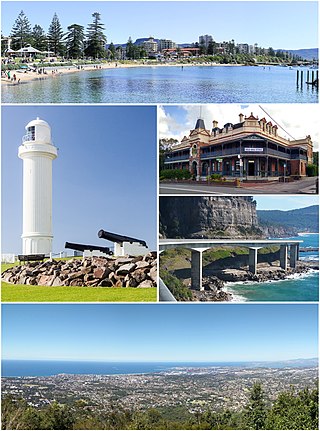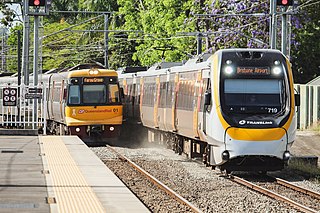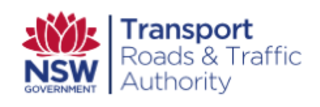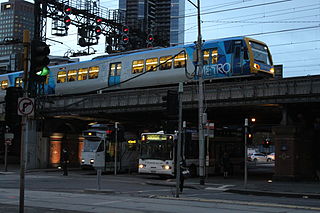
An extensive multi-modal transport system serves the state of New South Wales , Australia. The lead government agency responsible for the network's operation and development is Transport for NSW.

An extensive multi-modal transport system serves the state of New South Wales , Australia. The lead government agency responsible for the network's operation and development is Transport for NSW.
Transport for NSW is the main New South Wales Government agency responsible for major road infrastructure, licensing of drivers, and registration of motor vehicles. It directly manages State roads and provides funding to local councils for regional and local roads. In addition, with assistance from the Federal Government, Transport for NSW also manages the NSW national highway system.
Across the state, the RMS manages 4,787 bridges and 17,623 km of state roads and highways including 3,105 km of National Highways.
During the 20th century the railways were run by state-owned entity the New South Wales Government Railways and its successors. The current entity responsible for running the railways is Transport for New South Wales (TfNSW), with NSW TrainLink and Sydney Trains responsible for service provision and Transport Asset Holding Entity being the infrastructure owner. Freight services were operated by the state government through FreightCorp until 2001, when this business was sold to Pacific National. Since 2003, the NSW interstate and Hunter Valley rail corridors, and the dedicated metropolitan freight lines to the Sydney ports have been under the control of the Australian Rail Track Corporation. The rest of the network outside of Sydney is maintained under contract by John Holland.
According to the New South Wales State Plan, the state has Australia's largest public transport system. Indeed, in the 1920s, Sydney also boasted the southern hemisphere's largest tram network. Public transport in Sydney accounts for almost double the share of commuter journeys in other state capitals. The network is regulated by TfNSW, which is working towards an integrated network serving Sydney, Newcastle, the Central Coast, the Blue Mountains, Wollongong and the Illawarra.
New South Wales is served by a fleet of around 6,000 taxis. The industry employs over 22,000 taxi drivers. The network is the largest in Australia. Most taxis are Ford Falcons, Holden Commodores and Toyota Camrys, although a smaller number of Ford Fairlanes, Holden Statesman/Caprices and Toyota Priuses are in service. In general, taxis are required to run on liquid petroleum gas. In general, individual taxis are owned by small-scale operators who pay membership fees to regional or citywide radio communication networks. These networks provide branding as well as telephone and internet booking services to operators and drivers.
The major airport is Sydney Airport. The Western Sydney Airport is scheduled to open in 2026.
Major seaport facilities are located at
Regional ports at Eden and Yamba are administered by Transport for NSW. [1] [2]

New South Wales is a state on the east coast of Australia. It borders Queensland to the north, Victoria to the south, and South Australia to the west. Its coast borders the Coral and Tasman Seas to the east. The Australian Capital Territory and Jervis Bay Territory are enclaves within the state. New South Wales' state capital is Sydney, which is also Australia's most populous city. In December 2021, the population of New South Wales was over 8 million, making it Australia's most populous state. Just under two-thirds of the state's population, 5.3 million, live in the Greater Sydney area.

There are many forms of transport in Australia. Australia is highly dependent on road transport. There are more than 300 airports with paved runways. Passenger rail transport includes widespread commuter networks in the major capital cities with more limited intercity and interstate networks. The Australian mining sector is reliant upon rail to transport its product to Australia's ports for export.

Wollongong, colloquially referred to as The Gong, is a city located in the Illawarra region of New South Wales, Australia. The name is believed to originate from the Dharawal language, meaning either 'five islands/clouds', 'ground near water' or 'sound of the sea'. Wollongong lies on the narrow coastal strip between the Illawarra Escarpment and the Pacific Ocean, 85 kilometres south of central Sydney. Wollongong had an estimated urban population of 302,739 at June 2018, making it the third-largest city in New South Wales after Sydney and Newcastle and the tenth-largest city in Australia by population. The city's current Lord Mayor is Gordon Bradbery AM who was elected in 2021.

The National Highway is a system of roads connecting all mainland states and territories of Australia, and is the major network of highways and motorways connecting Australia's capital cities and major regional centres.

CityRail was a passenger railway brand operated by the State Rail Authority from 1989 to 2003 and by RailCorp from 2003 to 2013 with services in and around Sydney, Newcastle and Wollongong, the three largest cities in New South Wales, Australia. It was established in January 1989 and abolished in June 2013 when it was superseded by Sydney Trains and NSW TrainLink.

Highways in Australia are generally high capacity roads managed by state and territory government agencies, though Australia's federal government contributes funding for important links between capital cities and major regional centres. Prior to European settlement, the earliest needs for trade and travel were met by narrow bush tracks, used by tribes of Indigenous Australians. The formal construction of roads began in 1788, after the founding of the colony of New South Wales, and a network of three major roads across the colony emerged by the 1820s. Similar road networks were established in the other colonies of Australia. Road construction programs in the early 19th century were generally underfunded, as they were dependent on government budgets, loans, and tolls; while there was a huge increase in road usage, due to the Australian gold rushes. Local government authorities, often known as Road Boards, were therefore established to be primarily responsible for funding and undertaking road construction and maintenance. The early 1900s saw both the increasingly widespread use of motorised transportation, and the creation of state road authorities in each state, between 1913 and 1926. These authorities managed each state's road network, with the main arterial roads controlled and maintained by the state, and other roads remaining the responsibility of local governments. The federal government became involved in road funding in the 1920s, distributing funding to the states. The depression of the 1930s slowed the funding and development of the major road network until the onset on World War II. Supply roads leading to the north of the country were considered vital, resulting in the construction of Barkly, Stuart, and Eyre Highways.

Rail transport in Australia is a component of the Australian transport system. It is to a large extent state-based, as each state largely has its own operations, with the interstate network being developed ever since Australia's federation in 1901. As of 2022, the Australian rail network consists of a total of 32,929 kilometres (20,461 mi) of track built to three major track gauges: 18,007 kilometres (11,189 mi) of standard gauge, 2,685 kilometres (1,668 mi) of broad gauge, and 11,914 kilometres (7,403 mi) of narrow gauge lines. Additionally, about 1,400 kilometres (870 mi) of 610 mm / 2 ft gauge lines support the sugar-cane industry. 3,488 kilometres (2,167 mi), around 11 per cent of the Australian heavy railways network route-kilometres are electrified.

The Australian state of New South Wales has an extensive network of railways, which were integral to the growth and development of the state. The vast majority of railway lines were government built and operated, but there were also several private railways, some of which operate to this day.

The Roads & Traffic Authority (RTA) was an agency of the Government of New South Wales responsible for major road infrastructure, licensing of drivers, and registration of motor vehicles. The RTA directly managed state roads and provided funding to local councils for regional and local roads. In addition, with assistance from the federal government, the RTA also managed the NSW national highway system. The agency was abolished in 2011 and replaced by Roads & Maritime Services.
The State Rail Authority, a former statutory authority of the Government of New South Wales, operated and maintained railways in the Australian state of New South Wales from July 1980 until December 2003.

Transport in Melbourne, the state capital of Victoria, Australia, consists of several interlinking modes. Melbourne is a hub for intercity, intracity and regional travel. Road-based transport accounts for most trips across many parts of the city, facilitated by Australia's largest freeway network. Public transport, including the world's largest tram network, trains and buses, also forms a key part of the transport system. Other dominant modes include walking, cycling and commercial-passenger vehicle services such as taxis.

Transport in Sydney is provided by an extensive network of public transport operating modes including metro, train, bus, ferry and light rail, as well as an expansive network of roadways, cycleways and airports. According to the 2006 census, in terms of travel to work or study Sydney has the highest rate of public transport usage among the Australian capital cities of 26.3% with more than 80% of weekday trips to/from Central Sydney being made by public transport. According to the New South Wales State Plan, the state has Australia's largest public transport system. The public transport network is regulated by Transport for NSW.

Sydney, the largest city in Australia, has an extensive network of passenger and freight railways. The passenger system includes an extensive suburban railway network, operated by Sydney Trains, a metro network and a light rail network. A dedicated freight network also exists. Future expansion of the light rail network includes the Parramatta Light Rail. Existing light rail services are the Inner West Light Rail and the CBD & South East Light Rail.

General Holmes Drive is a 5-kilometre (3.1 mi) major divided road located in Sydney, New South Wales, Australia. The road forms part of the M1, the A1, the Sydney Orbital Network, and the Australian Highway 1 network. Initially built in 1919 as a two-lane road and duplicated in 1951, the road partially circumnavigates Sydney Airport with its north-eastern terminus in Mascot, heading west and then south and then south-west, with its south-western terminus with The Grand Parade in Brighton-Le-Sands.

Transport for NSW (TfNSW) is a New South Wales government transport and road agency established on 1 November 2011. The agency is a different entity to the New South Wales Department of Transport, a department of the New South Wales Government and the ultimate parent entity of Transport for NSW.

The New South Wales Metropolitan Rail Area (MRA) is the government-operated railway network centred on Sydney and bounded by Newcastle Interchange in the north, Bowenfels in the west, and Glenlee and Bomaderry in the south. The MRA contains the entirety of the state's electrified rail network. The MRA is owned by Transport Asset Holding Entity and maintained by Sydney Trains.
The 2010s saw many developments relating to transport in the Australian city of Sydney, New South Wales. The decade saw a substantial investment in infrastructure, including a new airport, motorway projects, light rail lines, Australia's first metro system, the new Waratah fleet and the demise of the non-air conditioned S sets from the rail network. Planning and branding of public transport services became substantially more centralised.
The Sydney Gateway is an under-construction major road interchange between the WestConnex and the airport terminals of Sydney Airport. Construction began in early 2021 and is expected to open in December 2024. It was originally planned to open in late 2023 in conjunction with the M4–M8 Link. The Sydney Gateway will also be constructed in conjunction with the duplication of the nearby Port Botany freight rail line, which is managed by the Australian Rail Track Corporation.

The Port Authority of New South Wales, is a corporation owned by the State Government of New South Wales, Australia. The Port Authority acts as harbourmaster at the State's six commercial seaports, managing shipping movements, safety, security and emergency response. While major cargo handling facilities are operated by the private sector, the Port Authority continues to manage smaller facilities including Sydney's two cruise terminals, at Circular Quay and White Bay; common user berths at Sydney's Glebe Island and White Bay; and the regional ports at Eden and Yamba.